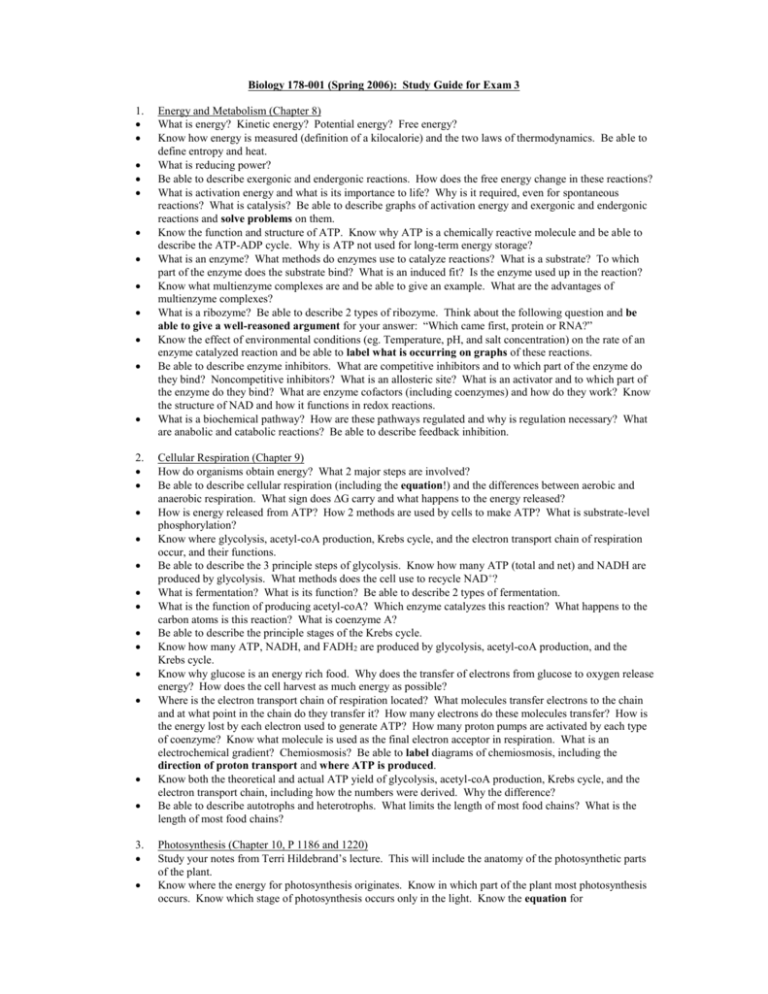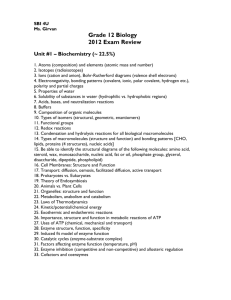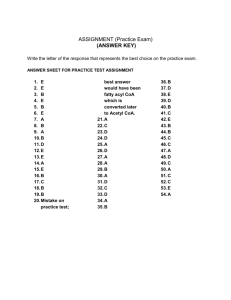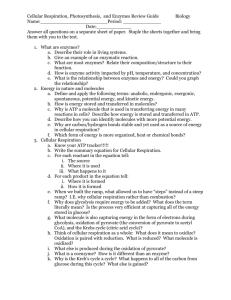Biol 178 Study Guide (Exam 3)
advertisement

Biology 178-001 (Spring 2006): Study Guide for Exam 3 1. 2. 3. Energy and Metabolism (Chapter 8) What is energy? Kinetic energy? Potential energy? Free energy? Know how energy is measured (definition of a kilocalorie) and the two laws of thermodynamics. Be able to define entropy and heat. What is reducing power? Be able to describe exergonic and endergonic reactions. How does the free energy change in these reactions? What is activation energy and what is its importance to life? Why is it required, even for spontaneous reactions? What is catalysis? Be able to describe graphs of activation energy and exergonic and endergonic reactions and solve problems on them. Know the function and structure of ATP. Know why ATP is a chemically reactive molecule and be able to describe the ATP-ADP cycle. Why is ATP not used for long-term energy storage? What is an enzyme? What methods do enzymes use to catalyze reactions? What is a substrate? To which part of the enzyme does the substrate bind? What is an induced fit? Is the enzyme used up in the reaction? Know what multienzyme complexes are and be able to give an example. What are the advantages of multienzyme complexes? What is a ribozyme? Be able to describe 2 types of ribozyme. Think about the following question and be able to give a well-reasoned argument for your answer: “Which came first, protein or RNA?” Know the effect of environmental conditions (eg. Temperature, pH, and salt concentration) on the rate of an enzyme catalyzed reaction and be able to label what is occurring on graphs of these reactions. Be able to describe enzyme inhibitors. What are competitive inhibitors and to which part of the enzyme do they bind? Noncompetitive inhibitors? What is an allosteric site? What is an activator and to which part of the enzyme do they bind? What are enzyme cofactors (including coenzymes) and how do they work? Know the structure of NAD and how it functions in redox reactions. What is a biochemical pathway? How are these pathways regulated and why is regulation necessary? What are anabolic and catabolic reactions? Be able to describe feedback inhibition. Cellular Respiration (Chapter 9) How do organisms obtain energy? What 2 major steps are involved? Be able to describe cellular respiration (including the equation!) and the differences between aerobic and anaerobic respiration. What sign does ∆G carry and what happens to the energy released? How is energy released from ATP? How 2 methods are used by cells to make ATP? What is substrate-level phosphorylation? Know where glycolysis, acetyl-coA production, Krebs cycle, and the electron transport chain of respiration occur, and their functions. Be able to describe the 3 principle steps of glycolysis. Know how many ATP (total and net) and NADH are produced by glycolysis. What methods does the cell use to recycle NAD +? What is fermentation? What is its function? Be able to describe 2 types of fermentation. What is the function of producing acetyl-coA? Which enzyme catalyzes this reaction? What happens to the carbon atoms is this reaction? What is coenzyme A? Be able to describe the principle stages of the Krebs cycle. Know how many ATP, NADH, and FADH2 are produced by glycolysis, acetyl-coA production, and the Krebs cycle. Know why glucose is an energy rich food. Why does the transfer of electrons from glucose to oxygen release energy? How does the cell harvest as much energy as possible? Where is the electron transport chain of respiration located? What molecules transfer electrons to the chain and at what point in the chain do they transfer it? How many electrons do these molecules transfer? How is the energy lost by each electron used to generate ATP? How many proton pumps are activated by each type of coenzyme? Know what molecule is used as the final electron acceptor in respiration. What is an electrochemical gradient? Chemiosmosis? Be able to label diagrams of chemiosmosis, including the direction of proton transport and where ATP is produced. Know both the theoretical and actual ATP yield of glycolysis, acetyl-coA production, Krebs cycle, and the electron transport chain, including how the numbers were derived. Why the difference? Be able to describe autotrophs and heterotrophs. What limits the length of most food chains? What is the length of most food chains? Photosynthesis (Chapter 10, P 1186 and 1220) Study your notes from Terri Hildebrand’s lecture. This will include the anatomy of the photosynthetic parts of the plant. Know where the energy for photosynthesis originates. Know in which part of the plant most photosynthesis occurs. Know which stage of photosynthesis occurs only in the light. Know the equation for photosynthesis. Know in which parts of the chloroplast the light reactions, Calvin cycle, and electron transport chain of photosynthesis occur. Know the functions of the light reactions and the Calvin cycle. Be able to make labeled drawings of chloroplasts (and mitochondria). Be able to describe, know the pupose, and the importance of the experiments of van Helmont, Priestly, Ingenhousz, Blackmann, van Niel, Hill, Arnon et al., Englemann, and Emerson and Arnold. Which parts of the electromagnetic spectrum are important for photosynthesis? Be able to describe photons and pigments. What are the major photosynthetic pigments and what wavelengths (colors) do they reflect and absorb? What happens to electron(s) when a photon is absorbed by such a molecule? What characterizes a molecule’s absorption spectrum? What is an action spectrum? Know the structure of the chlorophyll molecule. In which part of the molecule are electrons excited when a photon is absorbed? Which part anchors the molecule to the membrane? What is the basic structure of the carotenoids? Function? Why do leaves change color in the Fall? Know what photosystems are, including their component parts, and how they work. What did Emerson and Arnold discover about photosystems? Understand their results. Know the differences between plant photosystems I and II (including their peak wavelength, but not the number of subunits or number of pigments), where the high energy electrons originate from and where they end up. Know how ATP is made and where in the chloroplast it is made. Also, know the direction of proton pumping. What factors contribute to the proton gradient (think about this in advance)? At what point is NADPH made? Be able to compare the electron transport chains of photosynthesis and respiration – you WILL have multiple choice (and possibly short answer) questions on this. What are cyclic and noncyclic photophosphorylation? What is the purpose of cyclic photophosphorylation in bacteria and plants? Know what carbon fixation is and know the important steps of the Calvin cycle. Know the interrelationship between photosynthesis and respiration, including chemical recycling between the 2 processes. Be able to describe the carbon cycle. Which process produces the energy for life? What processes are shifting the balance between photosynthesis and respiration in the modern world? Be able to write essays or answer short answer questions on the consequences of deforestation for life (including the carbon and hydrologic cycles, biodiversity, soil fertility, and anything else you can think of) including your own opinions on this matter, and what might be done to resolve these problems – think about this in advance (study groups would be good for this)!!! Also, be aware of the additional problem of selective logging – be able to describe this and how recent research is showing that this process is contributing to the “deforestation problem” much more than previously anticipated). FOR THIS EXAM BE PREPARED TO WRITE ESSAYS AND TO HAVE THOUGHT CAREFULLY IN ADVANCE ABOUT THE CONCEPTS COVERED. STUDY GROUPS WOULD BE VERY HELPFUL FOR THIS. THESE TOPICS ARE NOT EASY ONES TO GRASP AND CANNOT BE STUDIED EFFECTIVELY OVERNIGHT (UNLESS YOU ARE A GENIUS!). YOU SHOULD STUDY THIS MATERIAL A LITTLE AT A TIME. THE CONSTRUCTION OF LABELED DRAWINGS AND TABLES WILL BE KEY TOOLS IN PREPARING FOR THIS EXAM. AFTER CAREFULLY STUDYING TAKE THE PRACTICE EXAM UNDER EXAM CONDITIONS AND BRING YOUR ANSWERS WITH YOU TO THE REVIEW SESSION ON TUESDAY, MARCH 21 (2 PM, SCIENCE 106).









